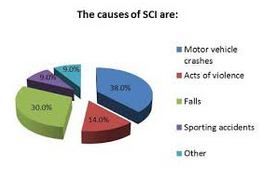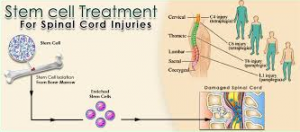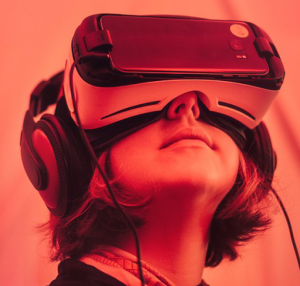New Spinal Cord Stem Cell Treatment combined with Exoskeleton and Virtual Reality
MD Stem Cells coordinates latest technologies to advance stem cell treatment of paraplegia
The study uses paraspinal injections of the stem cells in paralyzed patients both at the level of the damaged segment and segments above and below this level combined with intravenous and intranasal stem cells. Additions to this treatment may include exoskeletal mobility or virtual reality visualization to provide additional stimulation in the hoped for regeneration of motor and sensory neurons.
Paraspinal means next to the spinal nerves as they exit the spinal cord. By providing the stem cell injections adjacent to the spinal nerves it is expected that the stem cells will migrate into the spinal cord and nerves, potentially differentiate into neurons and support cells, as well as release growth factors that will positively affect the remaining nerve tissue. The MD Stem Cell researchers are combining up to 6 separate paraspinal injections given on both sides of the spinal cord at, above and below the spinal injury. By giving injections not only adjacent to the level of injury but also segments above and below, it is hoped that the axons - long thin segments of the motor neurons that travel from the brain down the spinal cord and control the muscles below the injury- will have greater regenerative potential. Similarly the axons of the sensory neurons that travel up the spinal cord to the brain and provide touch and other sensation from below the injury may have improved recovery. In addition to the neurons, it is hoped that the highly important neuro-glial cells which support and insulate the different neurons may also have opportunity to regenerate or heal.
Following the paraspinal injections, the remaining stem cells are provided intravenously which is in the vein in the arm, and intranasally which is within the nose. “In pre-clinical models, Bone Marrow Stem Cells (BMSC) given intravenously have been shown to pass through the lungs easily and enter the brain through the paraventricular organs” explained Dr. Steven Levy, CEO & President of MD Stem Cells, Study Director and developer of SciExVR. “The study also places BMSC intranasal because in pre-clinical models they may enter the brain through the 5th cranial nerves or Trigeminal nerves, entering the brain in the area through which motor and sensory neurons pass.” MD Stem Cells has never had a study using Fat or Adipose derived stem cells, also known as Stromal Vascular Fraction. Adipose stem cells are considered a poor choice because when given intravenously many get stuck in the lungs and never make it to the brain.
In some ways even more exciting is the combination of stem cells with Exoskeleton and Virtual Reality technology.
Exoskeleton is the use of supports powered by motors which allows patients with paraplegia to stand and walk. Exoskeleton has been used by itself to make some improvements in function but SciExVR is the first study to seek to combine stem cells with this technology. It is hoped that mechanical stimulation of proprioceptors below the injury, combined with adjacent stimulation of motor neurons in the brain, will augment the stem cell effects.
“Virtual Reality is very exciting because by engaging the brain in the thought of moving the legs, the brain sends signals down any remaining or partially functional motor neurons,” explained Dr. Levy. “The brain and the spinal cord are very adaptable and it is hoped that increasing spinal neuron stimulation through Exoskeleton and Virtual Reality will help increase the stem cells effects. This is the first effort to combine stem cells and VR in a comprehensive clinical study. ”
“It’s important to understand that we are using the patient’s own bone marrow stem cells and not stem cells from fat, adipose or what is sometimes called stromal vascular fraction” indicated Dr. Levy. “We have over 4 years of exceptional safety with the use of bone marrow stem cells. All our procedures are done in a fully licensed outpatient surgical facility under the auspices of board certified anesthesiologists in these operating rooms under the highest accreditation.”
In addition to Stem Cell Spinal Cord Injury Exoskeleton and Virtual Reality (SciExVR) National Clinical Trial (NCT) 03225625 for spinal cord injury resulting in paraplegia, MD Stem Cells is the Sponsor of the Stem Cell Ophthalmology Treatment Study II (SCOTS 2) NCT 03011541, and the Neurology Stem Cell Treatment study (NEST) NCT 02795052. The SCOTS 2 study is actively recruiting patients with different retinal and optic nerve diseases. The NEST study is actively recruiting and treating a variety of neurologic diseases including Parkinson’s disease (PD), Stroke (CVA), Traumatic Brain Injury (TBI), Multiple Sclerosis (MS), Peripheral Neuropathy and other neurologic diseases. All are Patient Supported studies meaning that there are no other sources of payment for the procedures other than the patients themselves. Because these are investigational treatments, insurances do not cover the costs.
Patients interested in treatment in SciExVR, SCOTS 2, or NEST may contact MD Stem Cells by email - stevenlevy@mdstemcells.com - by phone 203-423-9494 or by visiting the website www.mdstemcells.com and using the Contact Us page. All studies may be reviewed on www.clinicaltrials.gov and typing in the name of the study or the NCT number. Please follow us on Twitter @mdstemcells.com for updates about stem cell treatments.
Steven Levy
MD Stem Cells
203-423-9494
email us here
Legal Disclaimer:
EIN Presswire provides this news content "as is" without warranty of any kind. We do not accept any responsibility or liability for the accuracy, content, images, videos, licenses, completeness, legality, or reliability of the information contained in this article. If you have any complaints or copyright issues related to this article, kindly contact the author above.



